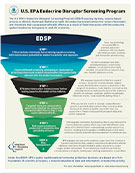July 29, 2015
Identifying endocrine disruptors – no policy change is not an option
A public consultation on defining criteria for identifying endocrine disruptors in the context of the implementation of the plant protection products regulation and the biocidal products regulation took place from 26 September 2014 to 16 January 2015 by on-line consultation questionnaire.
Respondents came from various parts of society and included doctors, farmers, nongovernmental organisations, chemical, electronic, food and medical devices industry, water companies and scientists) showing the diversity of use of these chemicals. This shows how widely these chemicals are used.
The opinions of respondents varied significantly on the options for criteria for determination of endocrine disrupting properties and for approaches to regulatory decision making.
In general, respondents expressed diverging views on how to define criteria and how endocrine disruptors should be regulated. Overall, responses suggested that there is a need for the EU to establish definitive criteria by the European Union for endocrine disruptors. Option 1 (no policy change, the interim criteria set in the plant protection products and biocidal products regulations continue to apply) is not therefore supported by the consultation.
Many respondents raised issues in relation to food safety, the threat that endocrine disrupting substances might pose to human health and/or the environment and the impact of the different options proposed in the roadmap on agriculture, industry, health and environment.
In particular farmers and agri-business highlighted the potential high implications of setting criteria to identify endocrine disruptors on agriculture. Authorities from non-EU countries stressed the potential impact on trade. A risk-based approach for regulating endocrine disruptors was proposed by many respondents. Many respondents supported the use of the WHO/IPC 2002 definition as a starting point for defining an endocrine disruptor. The public consultation provided an overview on the type and size of impacts that may occur if a chemical would be identified as an endocrine disruptor, the methodologies that may be used to obtain this type of information and also data and references to studies and articles to be considered in the impact assessment. The outcome of the public consultation provided useful input for impact assessment process that addresses the economic, environmental and health impacts of the different policy options.



